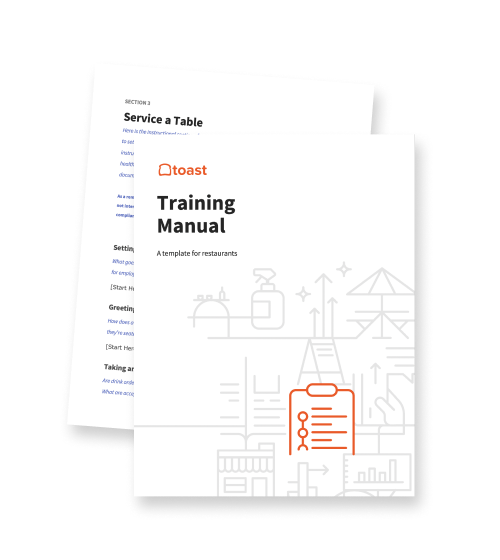
Stage Shifts: A Comprehensive Guide On What They Are And How To Do Them
Follow this guide on what stage shifts are and why you should view them as a fantastic opportunity for your career.

Tessa ZuluagaAuthor


Training Manual Template
Use this restaurant training manual template, a customizable Word Doc, to provide your staff with the rules, guidelines, and clarity they need to do their jobs efficiently.
What is a restaurant stage shift?
A stage shift is an unpaid training shift where the potential new staff member can experience what a shift in that restaurant is like, while also learning the skills for the job from the current staff.
Have you ever wondered what it would be like to work in a busy restaurant kitchen or manage the dining room as a server? Or, have you ever wanted to know if you’d be a good fit working at your favorite restaurant? If so, implementing stage shifts in your career journey may be the perfect opportunity to gain firsthand experience in the restaurant industry.
In this article, we will explore:
The origin of stage shifts
The reasons why restaurants implement them
A breakdown of front-of-house and back-of-house stage shifts
The best tips and practices for a successful stage shift experience
Ready to learn how stage shifts can provide valuable learning opportunities and foster talent? Let’s get started.
Server Training Checklist
Use this comprehensive checklist to streamline your training process and cover all the essential tasks new servers should learn, from basic steps of service to side work.

What is a stage shift?
The concept of stage shifts originates from the prestigious culinary industry in Europe, notably in countries like France. A stage (pronounced "stahj") comes from the French word stagiaire meaning trainee. Traditionally, this refers to an unpaid internship where aspiring chefs receive valuable, hands-on training in renowned culinary establishments. This practice allows them to learn from experienced professionals, expand their skills, and immerse themselves in the culinary world.
Over time, the stage shift concept has spread to other areas of the restaurant industry, encompassing both front-of-house and back-of-house positions. It’s more than a training session, it’s an experience to make sure you’re the right fit for the specific restaurant environment. If you’re going to spend many hours working in a restaurant you want to make sure you like it.
Why should you schedule stage shifts?
Skill development
Implementing stage shifts in restaurants provides aspiring professionals with invaluable learning opportunities. It allows you to gain practical experience & skills, and understand the demands of working in a restaurant. Stage shifts create a hands-on learning environment where individuals can acquire knowledge from experienced professionals.
Recruitment
Restaurants that offer stage shifts can identify and nurture aspiring restaurant professionals who demonstrate exceptional talent and commitment. These shifts can serve as a talent acquisition tool, allowing restaurants to observe potential future employees in action and assess their suitability for permanent positions. By implementing stage shifts, restaurants can attract ambitious individuals eager to learn and contribute to their business.
Restaurant Operations Manual Template
Use this free template to easily outline all of your operating procedures and make day-to-day operations as consistent as possible.

Promote collaboration
Stage shifts can foster collaboration. Bringing in fresh perspectives can lead to an improvement in current restaurant operations and guest experience. By inviting individuals with diverse backgrounds and ideas to participate in stage shifts, restaurants create a supportive environment that promotes growth and innovation.
Front-of-house stage shifts
Stage shifts can be implemented in both front-of-house (FOH) and back-of-house (BOH) positions. The focus and responsibilities differ in each area.
In FOH stage shifts, individuals have the opportunity to gain practical experience in customer service, guest interaction, and managing the dining room. FOH stage shifts may involve tasks such as greeting guests, taking orders, handling payments, and ensuring overall guest satisfaction. These shifts provide insights into the busy responsibilities of the FOH team and the impact they have on the dining experience.
I personally have staged as a front-of-house worker at a fast-paced restaurant. This shift was valuable to me because I got a feel for the flow of the restaurant and the personalities of my co-workers. This way, I started one step ahead of my training shifts. It was also a great opportunity to take a step back and see what truly makes a great dining experience at that specific restaurant. Lastly, it was nice to know I was comfortable with my co-workers and the environment was a good fit for me.
Back-of-house stage shifts
BOH stage shifts expose individuals to the fast-paced environment of the kitchen, allowing them to work alongside experienced chefs and kitchen staff. Participants may assist with food preparation, plating dishes, maintaining cleanliness and organization, and collaborating with the BOH team to deliver high-quality food to guests. BOH stage shifts offer a glimpse into the behind-the-scenes operations and the meticulous attention to detail required for successful culinary execution.
Stage shift best tips and practices
Choose the right restaurant
Before scheduling a stage shift, research and choose a restaurant that aligns with your goals and interests. Understanding the restaurant's cuisine, values, and reputation ensures a more meaningful learning experience.
Communicate expectations
Before starting a stage shift, it’s essential to communicate expectations and objectives with the restaurant management. Clarify the duration of the shift, tasks to be performed, and mutually agreed-upon learning goals. This establishes a clear framework for the stage shift experience.
Observe and Learn
During the stage shift, focus on observing and learning from experienced professionals. Pay attention to their techniques, communication skills, and problem-solving abilities. Seek opportunities to ask questions and gain insights into their experiences.
Embrace a positive attitude
Approach the stage shift with a positive attitude, eagerness to learn, and a strong work ethic. Seek opportunities to contribute to the team. This mindset not only enhances the stage shift experience but also leaves a lasting impression on the restaurant staff. If you want to get hired there, make sure they know you’re going to work hard.
Seek feedback
At the end of the stage shift, request feedback from the restaurant staff to further your growth. Reflect on the experience, jotting down key learnings and areas for improvement. Use this feedback to refine your skills and knowledge as you progress in your culinary journey.
This experience is an opportunity
Stage shifts are a valuable practice in the restaurant industry that offers you the chance to gain hands-on experience. By implementing stage shifts, restaurants can foster skill development, recruit promising talent, and encourage collaboration. Whether it’s a front-of-house or back-of-house stage shift you can learn from the staff and contribute to the success of the restaurant. By following these best tips and practices, you can make the most out of your stage shift experience, setting a solid foundation for a successful career in the restaurant industry.
Is this article helpful?
DISCLAIMER: This information is provided for general informational purposes only, and publication does not constitute an endorsement. Toast does not warrant the accuracy or completeness of any information, text, graphics, links, or other items contained within this content. Toast does not guarantee you will achieve any specific results if you follow any advice herein. It may be advisable for you to consult with a professional such as a lawyer, accountant, or business advisor for advice specific to your situation.
Read More
Subscribe to On the Line
Sign up to get industry intel, advice, tools, and honest takes from real people tackling their restaurants’ greatest challenges.



